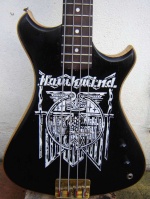Brass tarish/lacquer removal and brass bridge maintenance tips
Page 1 of 1
 Brass tarish/lacquer removal and brass bridge maintenance tips
Brass tarish/lacquer removal and brass bridge maintenance tips
Love em or hate them - the old Thunder, Concord and Paduak brass bridges eventually get really tatty, as do the brass knobs!
An antique restorer friend of mine gave me the tip, years ago, to use household ammonia and fine grade wire wool. Not only does this remove decades of tarnish in minutes, it also removes what's left of the factory applied lacquer too.
I tend not top bother re-lacquering. Just an in-situ polish, every 3 or 4 string changes suffices for me on my basses.
There is a bit of a rumour that ammonia makes brass brittle, but the amounts used, and the infrequency of use - well - suffice it say, I've never ever seen brass failure. However - it's smelly stuff, so best done outside!
I always dismantled the bridges down to component parts, removing all grub screws and intonation screws, soaking the latter in WD40 overnight). If you cant's get them out, soak the entire bridge in WD40, or penetrating solution overnight.
When re-assembling, I've often replaced the height grub screws for shorter ones. and always use stainless steel versions. If you can get a nice low action - especially on thunder basses - far too much grub screw is sticking out of the top of the saddle, with the original height screws, making palm muting a right pain! I've done this on Schaller Himass bass bridges, and even replaced the two height posts on both my Ricky basses too.
Standard Westone bass grub screws are M3 x 15mm, and for pence you can replace them with 12mm or even 10mm grub screws.
My Concord guitar has M3 x 8mm grub screws, and the 1981 Paduak (with the mk1 bridge) has M3 x 10mm screws.
This is after just 10 minutes of TLC - just think what an hour would achieve:

An antique restorer friend of mine gave me the tip, years ago, to use household ammonia and fine grade wire wool. Not only does this remove decades of tarnish in minutes, it also removes what's left of the factory applied lacquer too.
I tend not top bother re-lacquering. Just an in-situ polish, every 3 or 4 string changes suffices for me on my basses.
There is a bit of a rumour that ammonia makes brass brittle, but the amounts used, and the infrequency of use - well - suffice it say, I've never ever seen brass failure. However - it's smelly stuff, so best done outside!
I always dismantled the bridges down to component parts, removing all grub screws and intonation screws, soaking the latter in WD40 overnight). If you cant's get them out, soak the entire bridge in WD40, or penetrating solution overnight.
When re-assembling, I've often replaced the height grub screws for shorter ones. and always use stainless steel versions. If you can get a nice low action - especially on thunder basses - far too much grub screw is sticking out of the top of the saddle, with the original height screws, making palm muting a right pain! I've done this on Schaller Himass bass bridges, and even replaced the two height posts on both my Ricky basses too.
Standard Westone bass grub screws are M3 x 15mm, and for pence you can replace them with 12mm or even 10mm grub screws.
My Concord guitar has M3 x 8mm grub screws, and the 1981 Paduak (with the mk1 bridge) has M3 x 10mm screws.
This is after just 10 minutes of TLC - just think what an hour would achieve:


thunduak-1- Westone Nut
- Number of posts : 39
Registration date : 2008-04-09
 Similar topics
Similar topics» bridge pin removal
» Ovation Celebrity CC28 for Repair
» Budding Young Luthier Needs Help With Knobs!
» Wanted : Thunder I brass knobs
» Considering Adjustable Brass Nut?
» Ovation Celebrity CC28 for Repair
» Budding Young Luthier Needs Help With Knobs!
» Wanted : Thunder I brass knobs
» Considering Adjustable Brass Nut?
Page 1 of 1
Permissions in this forum:
You cannot reply to topics in this forum
 Website
Website Facebook
Facebook